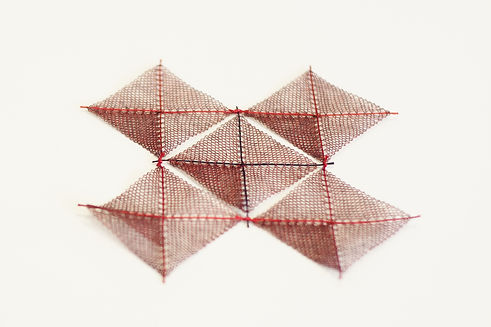BIONIC LACE
Traditional craft of lace making is known for depicting intricate plant and floral patterns.
Radices Laceum Bionica (bionic lace roots) takes this heritage as a starting point and radically transforms the formal expression and the functionality of the lace. It constructs large scale adaptive 3D lace rope-based structures serving as climbing grids for air purifying plants and scentful flowers. Ropes offer moist and are easily penetratable by the roots of the plants. The evolving evergreen structures of Radices Laceum Bionica will rejuvinate public interiors by bringing disruptive natural landscapes that meander, breath and purify the air.

Type
Research Project
Team
Samira Boon, Anna Sitnikova, David Prior Hope, Vivian Ertsieck
Collaborators
Margreeth Heijs (lace artist)
Touwslagerij Steenbergen
Supported by
Creative Industries Fund NL
Completion
Ongoing


“The basic idea of sustainability, after all, is that we should walk lightly on the earth.”
Conny Bakker, professor of Design Methodology for Sustainability and Circular Economy, TU Delft.
EXPLORATION & CREATION
Architecture weight reduction is an important factor to become more sustainable. It is often supposed that heavy, robust architecture is safer, stronger and more durable. However, this principle is expensive for the environment, being highly inefficient in terms of energy, production, transport, reuse.
We believe that a healthy and sustainable architecture is efficient: no material is wasted and all elements carry their fair share of the load. But how can we lose what weighs us down without compromising safety, convenience and durability?


With the research project BIONIC LACE we take the first steps in implementing our vision of a light and energy-efficient architecture of the future. We take nature as a role model. In nature, structural efficiency and economical use of materials are achieved through the ingenuity of form. We can learn how a minimum of materials can create maximum effect from the intriguingly complex single-cell organism Radiolaria or from the intricate spider webs. The artistry and craftsmanship of lace-making embody this nature-inspired concept of the ‘less is more’ economy: fewer materials – more design.

BIONIC LACE establishes a constant loop between the rope maker, the lace crafter and the designer. This approach allows to discover synergies within the inevitable trinity of technology: materials, processes and concepts and ultimately create harmonies between material, shape and production process. Finding the right combinations, where the lace structure and the rope structure enhance each other’s qualities will lead to a more effortless (energy efficient), naturally grown total design.




BIONIC LACE develops 3D laces based on the lace heritage of ingenious yarn binding techniques, along with the development of custom fibres and ropes to support the functionality of the 3D lace structures for interior architecture applications.


_edited.jpg)

